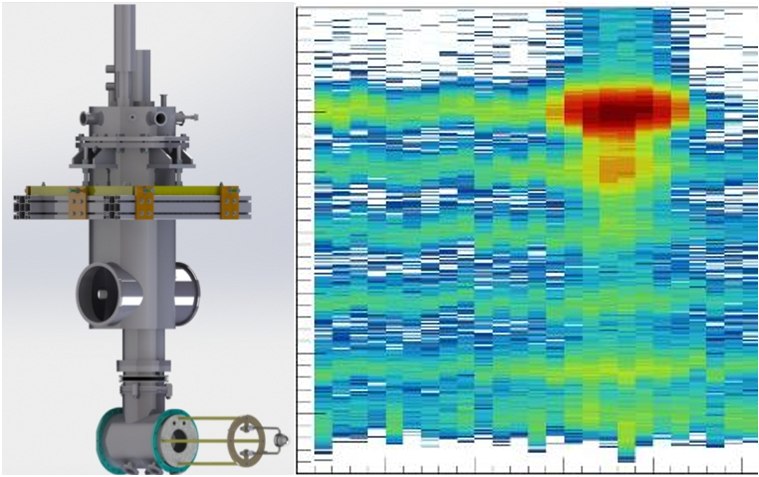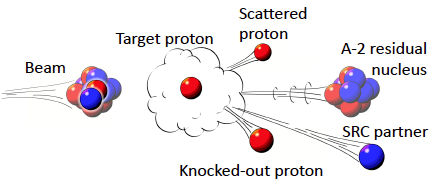
A droite, la cible liquide et le cryostat du projet Cocotier pour COrrélations à COurte porTée et spin IsotopiquE à R3B. A gauche, la répartition des numéros atomiques sur les scintillateurs.
The first measurement of Short-Range Correlations (SRC) in an exotic nucleus took place in May 2022 with the Cocotier instrument at the GSI facility in Darmstadt, Germany. This experiment is a milestone in the program that was started in 2017 with a grant from the French Research Agency that allowed physicists to build a liquid hydrogen target (see previous highlight). The goal of this experiment is to test the hypothesis that nucleon can form compact pair, the so-called SRC pair. This measurement campaign allowed us to gathered experimental data for about 60 hours with 16C beam and with a 12C beam for approximately 40 more hours in order to have a reference measurement with a well-studied stable beam. The IRFU team took a major role in preparing and running of this experiment, and is now in charge of the data analysis together with MIT, TU Darmstadt and LIP Lisbon team.
Under many respects the atomic nucleus can be seen as a crowd of nucleons each one behaving on its own except for the fact that they are kept together by a potential well. This is what is called “independent particle approximation”. To achieve a more realistic description of nuclei, one has to take into account correlations among its constituents, the above-mentioned nucleons. Measuring observables that keep the footprint of these correlations, and include them in theoretical models, is currently the effort of many nuclear physicists.
Among those correlations, SRC are the ones that occur when the nucleons come so close together to almost overlap and strongly repel each other. Most of what we know about SRC in nuclei has been learnt by probing stable nuclei with an electron beam [1] sent on a fixed nuclear target. This cannot be done with unstable nuclei whose lifetimes are often smaller than 1 second, like 16C that was chosen for this experiment.

Fig 1 Sketch of the process corresponding to scattering on an SRC pair. The target proton » hit a pair that is ejected into two componant: the knocked-out proton and the SRC partner, leaving the rest of the core, the A-2 residual nucleus.
Therefore, we had to reverse the paradigm and use a beam of 16C, that in our case was produced via fragmentation of 18O primary beam accelerated by GSI synchrotron, and subsequently selected via the GSI fragment separator. Our 16C beam is then sent on a target made of hydrogen, i.e. protons, triggering scattering processes as shown in Fig. 1. From time to time, the protons in the target happen to knock-out a nucleon who is not sitting alone in the crowd of 16C.
What we know is that, after this collision, there are three nucleons leaving the nucleus: the one from the target, the one that was hit, and a third one. The latter displays some properties that induce us to think that before being disturbed he was sitting with the second one in a compact pair, the so-called SRC pair. Testing this interpretation is one of the goals of this experiment. Investigating if and how the SRC pairs are modified in the neutron rich environment of 16C, is the specific goal of this experiment.
In order to demonstrate that the reversed paradigm works, the same team performed a pilot experiment in 2018 at Dubna facility with a stable 12C beam. The results were recently published in Nature Physics [2] (see FM A glimpse of nuclear couple through transparent nuclei). The identification of the residual nucleus was shown to be an asset in order to find the few events of interest in the sea of all possible reaction processes. Overall, to reconstruct this kind of events we need to measure at least 4 particles emitted, i.e. the residual nucleus (the beam minus the removed SRC pair), the proton from the target, and the two nucleons from the pair (knocked-out proton and SRC partner in Fig. 1).
This time at GSI with the unstable 16C beam, tackling this challenge was the role of the R3B setup that can be seen in Fig. 2.

Fig. 3 Left: the liquid hydrogen target support and the cell, partially hidden by the FOOT detectors surrounding it. Right: the scattering chamber surrounded by the CALIFA calorimeter and surmounted by the target cryostat.
At the heart of the R3B setup is the COCOTIER liquid hydrogen target built and operated by the IRFU team. The target can be seen in Fig. 3 (bottom left), surrounded by and array of Single Sided Silicon Detectors called FOOT used to track the scattered and knock-out proton. The ensemble was placed in vacuum in the scattering chamber that can be seen in Fig. 3, right, that is herself surrounded by a calorimeter allowing to detect the energy of the protons and possible gamma rays emitted by the excited residual nucleus.
After leaving the target at forward angles, the residual nucleus and the SRC partner will go through the GLAD dipole magnet, that allows to separate the different particles and send them to different detectors dedicated to measure each of them. As an illustration, the measurement of the atomic number Z of the residual nucleus emerging from GLAD is shown in Fig. 4. As expected, most of the 16C beam (Z=6) passes through the target undisturbed, but a small fraction undergoes a reaction. A large part of the SRC events we are looking for are expected to be in coincidence with the 14Be nucleus (Z=4), for example.
The experiment run in two parts. In the first part, we gathered experimental data for about 60 hours with 16C beam. We repeated the process with a 12C beam for approximately 40 more hours in order to have a reference measurement with a well-studied stable beam. Overall, we successfully collected the expected statistics and each detector of the R3B setup performed well thanks to the efforts of an international team of about 80 physicists.
The IRFU team had a key role in this experiment: coordination, operation of the liquid hydrogen target and of the Time of Flight wall for the residual nucleus, and participation in the efforts to adapt FOOT electronics to the high counting rate demanded by this experiment.
The data collected will be the subject of a thorough analysis in the coming years and are expected to be matter for at least 4 PhD thesis, including one taking place at DPhN. Overall, the measurement campaign is a major step in the SRC experimental studies. It will hopefully unlock our understanding of the behaviour of the nucleons within the nuclear medium.
[1] Duer M. et al. (CLAS Collaboration), Nature, 560:617, 2018.
[2] Patsyuk, M., Kahlbow, J., Laskaris, G. et al. Nat. Phys. (2021).
• Structure of nuclear matter › Atomic nucleus
• Institute of Research into the Fundamental Laws of the Universe • The Nuclear Physics Division
